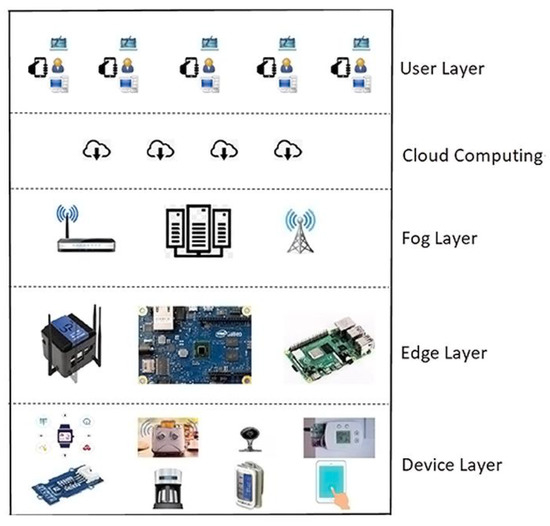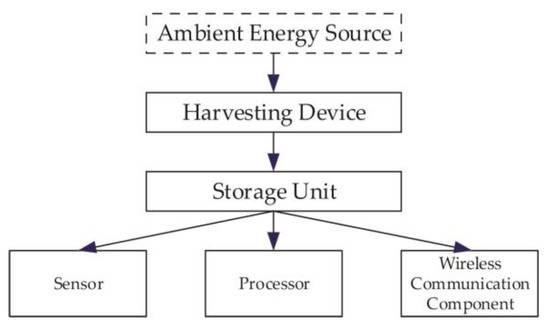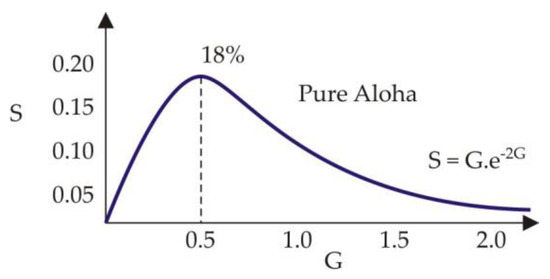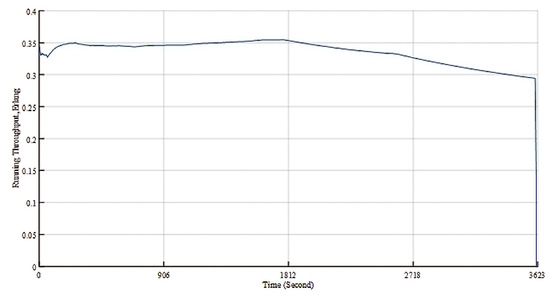Abstract
In recent years, wireless sensor networks (WSNs) have attracted rising interest due to their significant role in Internet of Things (IoT) applications. One of the most important layers of the IoT is known as edge computing, and WSNs typically act as microcontroller-driven edge objects. It is a well-known phenomenon that objects composing a WSN are resource-constrained devices in terms of energy. This paper aims to revisit the traditional ALOHA protocol as a medium-access control with the purpose of creating a solar-powered energy source. A simple network of 6 objects is created to test the performance of the ALOHA protocol in terms of its lifetime. The performance results reveal that the network lifetime can be increased by controlling the parameters, such as transmission power level and packet length.
1. Introduction
Wireless sensor networks (WSNs) have long been an attractive research domain due to their wide range of application areas that cover all aspects of life [1]. The reputation of WSNs is that they have the capability to continuously monitor real-world conditions in harsh environments with no human access. From the past to the present, a significant amount of effort has been carried out to design more efficient and intelligent WSN-based applications. These studies have aimed to handle the main limitations in WSNs, whereby an energy-efficient solution is often employed to remove the constrained-energy burden. It is worth mentioning that several tiny nodes comprise a typical WSN, which are powered using limited energy sources. Therefore, effective utilization of existing energy budgets in nodes is of paramount significance, as nodes with exhausted energy will remain inactive. To protect the entire performance of a WSN, the redundant energy consumption in each node must be minimized. The most energy-consuming component of the nodes is the wireless communication unit, whereas the computation part consumes much less energy. This process requires the coordination of the communication unit among the nodes in an energy-efficient manner. To minimize this problem, state-of-the-art approaches render these networks’ energy-efficient operation as a primary focus [2].
Today, WSNs play a key role in the Internet of Things (IoT) [3]. This fact is because the first layer of the IoT structure requires a physical parameter, making WSNs good candidates. To better visualize this phenomenon, an entire structure of an IoT mechanism is presented in Figure 1. In this figure, the first layer includes devices that sense physical information to be reported to the edge layer. The edge layer performs an initial process and extracts meaningful information to be transferred to the upper layer for further analysis and storage purposes. Due to the increasing amount of data that needs to be processed, the edge layer is unable to handle its duties. Therefore, the systems with time-sensitivity face significant problems in terms of making critical decisions on time. This issue resulted in the development of a new layer—a fog layer—with more powerful hardware components. Cloud computing, on the other hand, represents a structure that usually resides in a single point on the Internet, which does not require any installation; thus, it can work from anywhere at an affordable cost. The final service is provided to the users through cloud computing.

Figure 1.
The layers of the IoT architecture.
Recent developments in energy-harvesting technologies have allowed traditional nodes to harvest ambient energy sources for perpetual operation, as presented in Figure 2 [4]. These nodes benefit from having an unlimited energy source, such as solar power, though the amount of harvestable energy exhibits an uncontrollable trend. For example, solar power may ensure low energy during morning times, which then approaches its peak value at noon, meaning that there is no energy to harvest at sunset. This nature has changed the development of traditional medium-access control (MAC) schemes that control the channel access of the nodes. In the literature, many MAC protocols have been proposed to enhance the performance of WSNs in terms of energy and channel throughput [5,6]. It is well understood that the performance of MAC protocols under the umbrella of energy-harvesting properties may vary significantly. Hence, evaluating such a performance can present important findings and novelties.

Figure 2.
WSN node architecture with energy harvesting capability.
The key contribution of this study is to revisit the ALOHA protocol, which is, perhaps, the first MAC scheme for WSNs. ALOHA has been a popular protocol in various branches of network domain. The main advantage of ALOHA is its simplicity for practical implementations, which makes it well-suited to resource-constrained nodes. ALOHA and its variants have been employed in many MAC protocols as baseline schemes. This paper presents a practical scenario to observe the performance of ALOHA with solar-powered nodes. A network that includes six transmitting nodes and one receiving node is constructed, with each node generating energy from a miniature solar panel. The entire lifetime of the network is evaluated to determine real-time running throughput. The following sections will outline the technical details of this network.
2. Background
2.1. Object with Energy Harvesting
Low-cost sensor hardware with solar power energy harvesting, which is known as the object in the IoT, is used to implement ALOHA protocol. The blocks of the object, as depicted in Figure 2, include the Arduino platform as the processor unit, an nRF24 L01 as the wireless communication component [7], a lithium polymer (LiPo) battery as the storage unit and a small solar panel as the harvesting device. The view of the object can be seen in Figure 3. The nRF24 L01 component allows at least a 300-meter communication range and a controllable data rate of up to 2 Mbps. To make the object cost-friendly, a small solar panel with a 3.7 V LiPo battery supplies the energy required to power the processor and communication units. The Arduino platform was selected as the brain of the object due to its lightweight programming IDE and simple approach to coding.

Figure 3.
Hardware components of the object.
2.2. Evaluation of ALOHA Protocol
ALOHA has a straightforward transmission policy that allows each object to start transmission immediately upon generating a packet. After a transmission, the transmitting object expects to receive a positive response from the receiving object, which represents the successful confirmation of reception. This response packet has a very small length, which is typically set to 1 byte, and is called the acknowledgement (ACK) packet. In cases of packet loss due to collisions, the responsible object will receive no ACK packet and treat the transmitted packet as collided and lost. Next, a retransmission process is started to retransmit the collided packet in sequence. A limit to the maximum number of retransmissions is set to 7, and the lost packet beyond this limit will be discarded. A random time, which is referred to as back-off time, is selected to allocate a duration among the successive retransmissions. This back-off time aims to reduce the probability of collisions by resending the collided packets at different time intervals. The whole process is presented in Figure 4. The objects are accepted to be in range of receiver unit, meaning that each object has a direct link to the receiver. The packet generation process is equally assigned to each node, which have the same average inter-arrival time. The packet length is also set to a constant length at the beginning. Another assumption is to allow the objects to transmit at the same power level. With its advantages, ALOHA has inspired the advancement of a lot of MAC schemes, having the key focus of improving the pure performance.

Figure 4.
A packet transmission process in ALOHA.
Due to the high number of collisions that result in packet destructions, the throughput performance of ALOHA is very low, as presented in Figure 5.

Figure 5.
Throughput performance of ALOHA with varying traffic loads.
The results indicate that the maximum channel throughput that can be obtained is 0.18 when the traffic load is 0.5. Therefore, researchers have been working to improve the throughput performance via popular techniques, such as reinforcement learning [8,9].
3. Performance Evaluation
This section of the paper demonstrates the performance results of the ALOHA, whereby a simple single-hop scenario is deployed by fully charging the batteries of all transmitting nodes at the onset of the running period. The performance of the ALOHA is evaluated in terms of channel throughput, which represents the ratio of the number of received packets to full channel capacity. To properly observe the throughput success, the overall generated traffic load is set to 1, which corresponds to a maximum occupation of channel transmission. Each node is associated with the Poisson traffic model for packet generation. The purpose of the implementation is to examine the behavior of throughput performance when there is no sunlight from which to harvest energy. This case is likely to occur in night times and when nodes consume energy from their stored energy capacity. Therefore, it is very important to observe the lifetime of the entire network after sunset. It is clear that the results obtained are valid for the used LiPo battery with 350 mAh capacity, which is suitable for nodes due to its low cost and small size features.
Figure 6 presents the running throughput of ALOHA in every second after the running commences. At the first underlying point, it can easily be noticed that the maximum throughput is almost double its theoretical value, which is limited to 0.18. The reason for this two-time increase was previously stated in our study [10]. Practical observations have shown that some packets can be decoded successfully when they collide. In particular, our previous study experimentally proved that the first-arriving packet in a collision has a chance of being received uncorrupted, which is called the capture effect.

Figure 6.
Running throughput of ALOHA.
The second outstanding result regarding the running throughput indicates that the lifespan of the network is about 1 h (~3600 s). Considering the duration of the sunless period of each day, such a network will be useless at most night times. We, therefore, infer that the energy consumption during night times should be minimized to keep the network alive. The first approach would be to minimize the packet-generation time, as the wireless transmission part expends a high level of energy. Another approach is to arrange the transmission power level provided by the radio transceiver, in which the nRF24 L01 module ensures four adjustable levels (0, −6, −12 or −18 dBm). The final means of reducing the power consumption is to decrease the packet length, which is set to 32 bytes of its maximum length.
4. Conclusions
This paper studies the performance of the ALOHA protocol in practice based on its energy-harvesting properties. With the capture effect, the practical throughput is found to be double that of the analytical calculation of the throughput. The actual running throughput was shown to observe the proper lifetime of the network based on sunset. The performance result shows that the networks’ parameters should be optimized to supply the required energy for a perpetual operation. The specific proposals related to these parameters were shown to possibly extend the network’s lifetime.
Author Contributions
The authors contributed equally to this work. All authors have read and agreed to the published version of the manuscript.
Funding
This research was funded by the Bursa Technical University Scientific Research and Development Support Program (BAP), grant number 210 Y013.
Institutional Review Board Statement
Not applicable.
Informed Consent Statement
Not applicable.
Data Availability Statement
No data to report.
Conflicts of Interest
The authors declare no conflict of interest.
References
- Rashid, B.; Rehmani, M. Applications of wireless sensor networks for urban areas: A survey. J. Netw. Comput. Appl. 2016, 60, 192–219. [Google Scholar] [CrossRef]
- Ketshabetswe, L.; Zungeru, A.; Mangwala, M.; Chuma, J.; Sigweni, B. Communication protocols for wireless sensor networks: A survey and comparison. Heliyon 2019, 5, e01591. [Google Scholar] [CrossRef] [PubMed]
- Kosunalp, S.; Kaya, Y. IoT-TDMA: A performance evaluation of TDMA scheme for wireless sensor networks with Internet of Things. Concurr. Comput. Pract. Exp. 2022, 34, e7063. [Google Scholar] [CrossRef]
- Sudevalayam, S.; Kulkarni, P. Energy harvesting sensor nodes: Survey and implications. IEEE Commun. Surv. Tutor. 2010, 13, 443–461. [Google Scholar] [CrossRef]
- Sadeq, A.S.; Hassan, R.; Sallehudin, H.; Aman, A.H.M.; Ibrahim, A.H. Conceptual Framework for Future WSN-MAC Protocol to Achieve Energy Consumption Enhancement. Sensors 2022, 22, 2129. [Google Scholar] [CrossRef] [PubMed]
- Sherazi, H.; Grieco, L.; Boggia, G. A comprehensive review on energy harvesting MAC protocols in WSNs: Challenges and tradeoffs. Ad Hoc Netw. 2018, 71, 117–134. [Google Scholar] [CrossRef]
- Datasheet for nRF24L01 Platform. Available online: https://www.sparkfun.com/datasheets/Components/SMD/nRF24L01Pluss_Preliminary_Product_Specification_v1_0.pdf (accessed on 1 May 2023).
- Kosunalp, S.; Mitchell, P.; Grace, D.; Clarke, T. Practical implementation and stability analysis of ALOHA-Q for wireless sensor networks. ETRI J. 2016, 38, 911–921. [Google Scholar] [CrossRef]
- Kosunalp, S.; Mitchell, P.; Grace, D.; Clarke, T. Practical implementation issues of reinforcement learning based ALOHA for wireless sensor networks. In Proceedings of the International Symposium on Wireless Communication Systems (ISWCS 2013), Ilmenau, Germany, 27–30 August 2013; pp. 360–364. [Google Scholar]
- Kosunalp, S.; Mitchell, P.; Grace, D.; Clarke, T. Experimental study of capture effect for medium access control with ALOHA. ETRI J. 2015, 37, 359–368. [Google Scholar] [CrossRef]
Disclaimer/Publisher’s Note: The statements, opinions and data contained in all publications are solely those of the individual author(s) and contributor(s) and not of MDPI and/or the editor(s). MDPI and/or the editor(s) disclaim responsibility for any injury to people or property resulting from any ideas, methods, instructions or products referred to in the content. |
© 2023 by the authors. Licensee MDPI, Basel, Switzerland. This article is an open access article distributed under the terms and conditions of the Creative Commons Attribution (CC BY) license (https://creativecommons.org/licenses/by/4.0/).